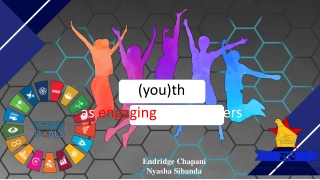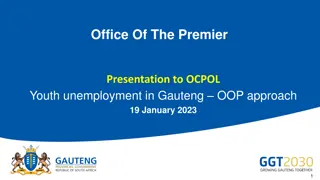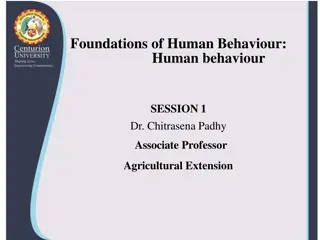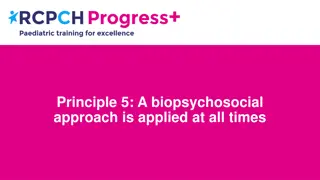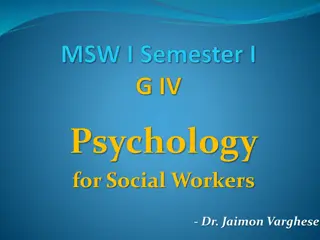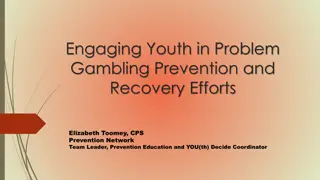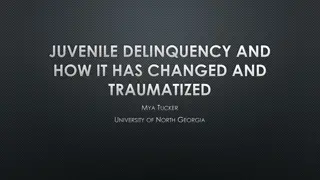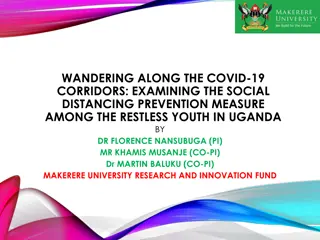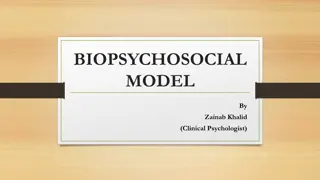Biopsychosocial Factors Influencing Youth Behavior
Factors such as genetic materials inherited from parents, cognition, emotion, motivation, society and community dynamics, and the biopsychosocial model play crucial roles in shaping individuals' behaviors and health outcomes. This comprehensive interplay between biological, psychological, and social factors can impact an individual's well-being, influencing their choices, actions, and overall quality of life.
Download Presentation

Please find below an Image/Link to download the presentation.
The content on the website is provided AS IS for your information and personal use only. It may not be sold, licensed, or shared on other websites without obtaining consent from the author.If you encounter any issues during the download, it is possible that the publisher has removed the file from their server.
You are allowed to download the files provided on this website for personal or commercial use, subject to the condition that they are used lawfully. All files are the property of their respective owners.
The content on the website is provided AS IS for your information and personal use only. It may not be sold, licensed, or shared on other websites without obtaining consent from the author.
E N D
Presentation Transcript
Genetic materials and processes inherited from one s parents Factors that include a person s physiology (i.e. how their cells, muscles and organs interact) Biological health that depends upon how these physical systems operate and interact together
Cognition Emotion Motivation
Perceiving Learning Remembering Thinking Interpreting Believing Problem solving
Thoughts Behaviours Physiology
Start an activity Choose an activity's direction Persist in an activity
Society and community Family relationships Friendships Mass media
Biopsychosocial model as a system dynamic entity with parts that are interrelated Dynamic active and ongoing Social Entity - person Interrelated - unified Biological Psychological Sarafino and Smith, 2014
Biological injury, medical condition, diet and exercise Psychological anxiety or worry, tension, depression, focusing on the pain, boredom and withdrawal from daily life activities Social isolation, loneliness, social exclusion Sarafino and Smith, 2014
Biological medication, surgery, change in diet and exercise Psychological positive emotions, e.g. optimism, contentment, motivation, rest, distraction Social connections with society, e.g. family, friends, local community, education, work, leisure and cultural activities Sarafino and Smith, 2014
For example, Maia is due in court, having been arrested for vandalism. Maia s background is as follows: Female, age 17 Lives with her family where no-one works Maia says she drinks alcohol on the streets with her friends because she is fed up Maia lives in an area experiencing significant social and economic disadvantage with high rates of teenage pregnancies
Social and cultural factors of drinking alcohol positive in some circles but negative in others Peer pressure amongst adolescents underage drinking is more likely amongst teenagers who experience depression Interaction between substance misuse and depression does the alcohol cause the depression or does the depression cause the substance misuse? An example of the interaction between biological and psychological factors Maia s sense of hopelessness because of her social context an example of the interaction between biological, psychological and social factors
Poor mental health affects many aspects of people s lives. On average, men with poor mental health die 20 years earlier and women die 15 years earlier than the general population (BMA, 2014). People with severe mental illness have an unemployment rate four times that of people with no illness (OECD, 2014). These statistics and references are identified in the Equality and Human Rights Commission (2015) report Is Wales Fairer? These statistics illustrate links between social issues and mental health.
The BSP model encourages us to explore the biological, psychological and sociological aspects of people s lives as interdependent elements even when a person presents a problem that they consider to be related to one specific area, e.g. physical pain. We are reminded that the three elements of the model are constantly interacting with each other, and consequently one element can influence and be influenced by the other.
Equality and Human Rights Commission (2015) Is Wales fairer? Available at: https://www.equalityhumanrights.com/en/publication-download/wales- fairer-report (Accessed: 7 October 2017). Sarafino, E. and Smith, T. (2014) Health psychology : biopsychosocial interactions. Eighth edition. Hoboken,NJ: John Wiley and Sons.


